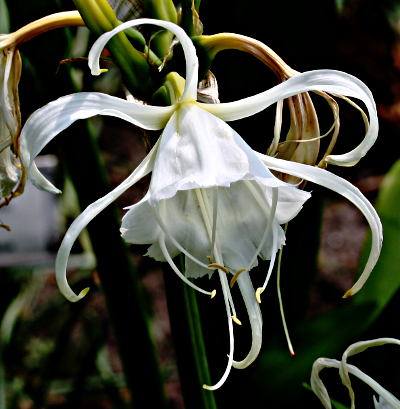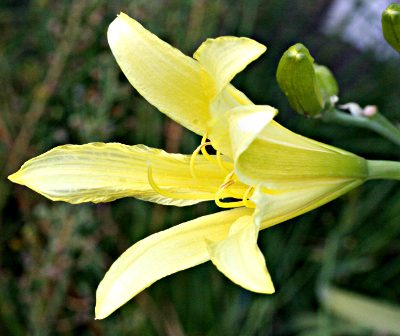Amaryllis family |

The Hymenocallis originate from South America

Hippeastrum species are often referred to as Amaryllis
The family amaryllidaceae comprises about 70 genera with about 1000 species, which has its origins in the warm temperate and the (sub-)tropical regions.
The perennial, herbaceous plants exclusively possess either bulbs or rootstocks (rhizomes). Their leaves are almost always basal, parallel-veined and linear to lanceolate.The scape bears a single flower at the top or several ones, which are often umbellarly arranged. They are hermaphroditic and consist of six tepals of the same appearance. The 6 stamens are arranged in 2 rows and inclined inwards. The mostly inferior ovary consist of 3 carpels and bears a stylus with 1–3 stigmas. After pollination, by the inferior ovary are formed capsules or berries, which are often possess numerous seeds.
| Floral formula: |
| * P3+3 bzw. P(3+3) A3+3 G(3) inferior |
Amaryllidaceae contain various toxic alkaloids, depending on the genus and species. Often lycorine, galanthamine, narcissine, crindine or tazettine occur. They protect plants from herbivores and parasites. Poisoning leads to nausea, vomiting, diarrhea, dizziness and sweating, in severe cases to convulsions, paralysis, kidney damage and heart failure.
Besides the already mentioned Jersey lily and daffodil many other ornamental plants of this family exist. These include snowdrops, dewdrops (spring snowflake), bush lilies, blood lilies and many others.
Under the name of Amaryllis two different house plants are traded. Firstly, the "real Amaryllis", the Jersey lily, and the "false Amaryllis", that belongs to the genus Hippeastrum. The same name is based on a relic from the time before the 20th century, when the genus Amaryllis has been understood more broadly. To distinguish: At the Jersey lily the leaves appears and wilt before flowering and its scape is are filled with pulp, at Hippeastrum the leaves appear after flowering and their scape is hollow.
Interesting notes
-
The toxins of Amaryllidaceae bulbs or those in the sap can already be harmful to the skin when touched. Especially with gardeners and florists skin irritation as "lily rash" or "daffodil-itch" is known.
The bulb of the Jersey lily is so toxic that even 2-3 g can lead to death. From the plant the natives of South Africa produced an arrow poison.